Strategy Development: AAA Model Analysis of Industries
VerifiedAdded on 2019/10/18
|13
|2541
|134
Report
AI Summary
This report delves into the AAA framework, encompassing Adaptation, Aggregation, and Arbitrage strategies, as proposed by Pankaj Ghemawat, to evaluate how companies create global value. The analysis focuses on two industries: the car industry, examining Toyota and Holden, and the airline industry, analyzing Virgin Australia Airlines and Jetstar Airways. The report investigates how each company implements the AAA model to tailor business models to local markets (adaptation), standardize value propositions for efficiency (aggregation), and exploit economic differences across markets (arbitrage). Specific examples, such as Toyota's regionalization strategy and Virgin Australia's airline-within-airline approach, illustrate the practical application of these strategies. The report concludes by comparing the effectiveness of each company's approach, highlighting how different companies have used these strategies to achieve business goals, and the effectiveness of each strategy in different business contexts, offering insights into the strategic choices made by these companies and their impact on market performance.
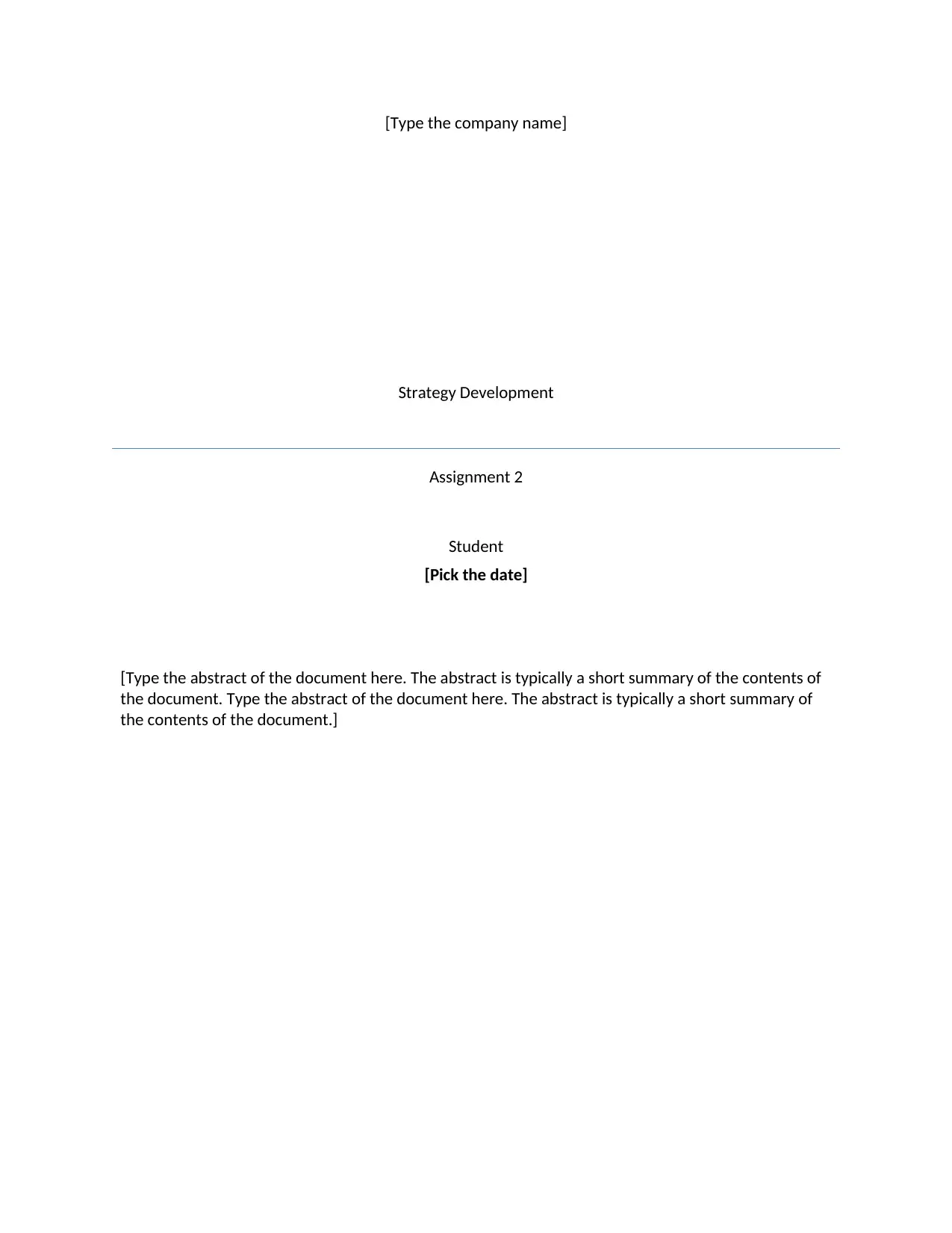
[Type the company name]
Strategy Development
Assignment 2
Student
[Pick the date]
[Type the abstract of the document here. The abstract is typically a short summary of the contents of
the document. Type the abstract of the document here. The abstract is typically a short summary of
the contents of the document.]
Strategy Development
Assignment 2
Student
[Pick the date]
[Type the abstract of the document here. The abstract is typically a short summary of the contents of
the document. Type the abstract of the document here. The abstract is typically a short summary of
the contents of the document.]
Paraphrase This Document
Need a fresh take? Get an instant paraphrase of this document with our AI Paraphraser
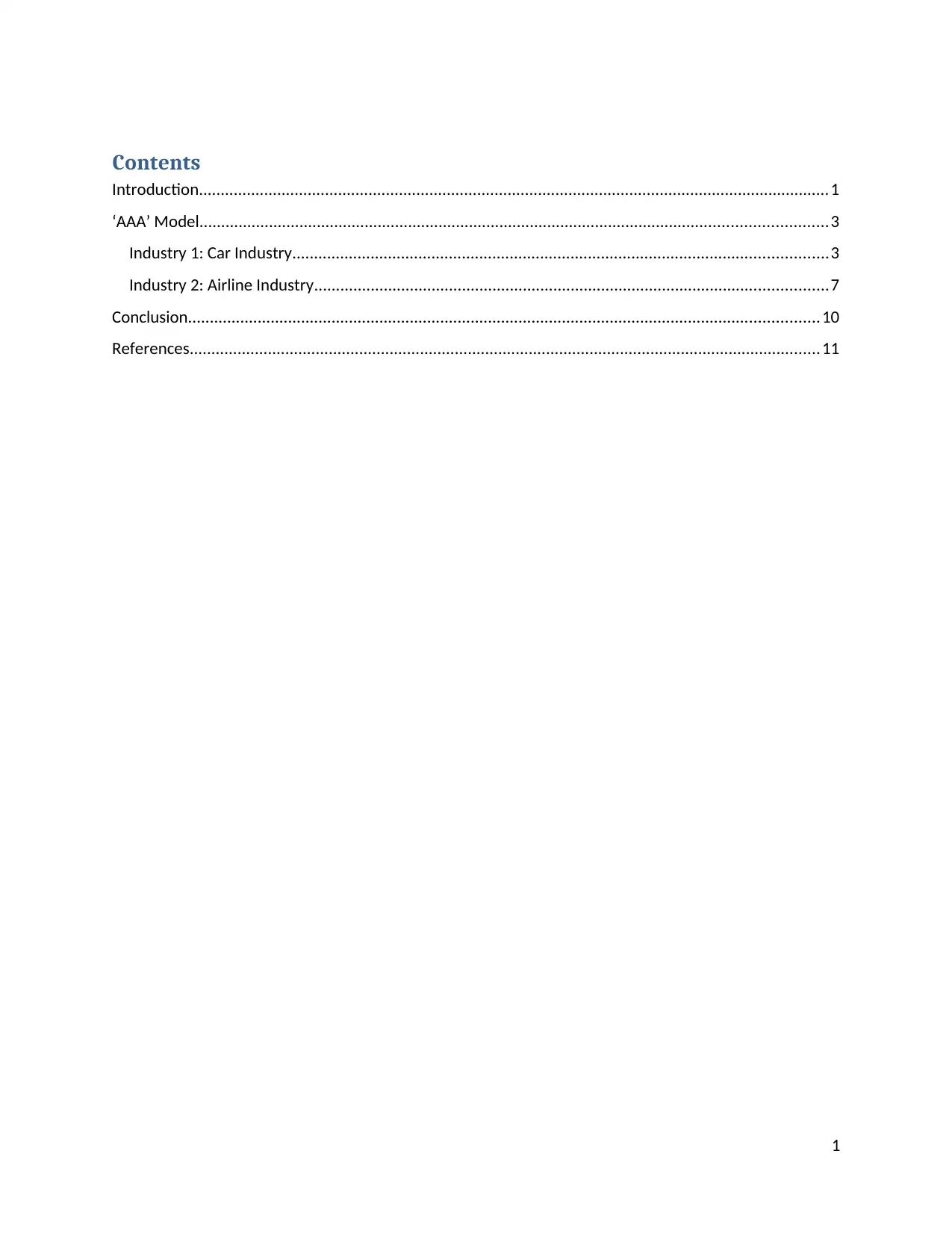
Contents
Introduction.................................................................................................................................................1
‘AAA’ Model................................................................................................................................................3
Industry 1: Car Industry...........................................................................................................................3
Industry 2: Airline Industry......................................................................................................................7
Conclusion.................................................................................................................................................10
References.................................................................................................................................................11
1
Introduction.................................................................................................................................................1
‘AAA’ Model................................................................................................................................................3
Industry 1: Car Industry...........................................................................................................................3
Industry 2: Airline Industry......................................................................................................................7
Conclusion.................................................................................................................................................10
References.................................................................................................................................................11
1
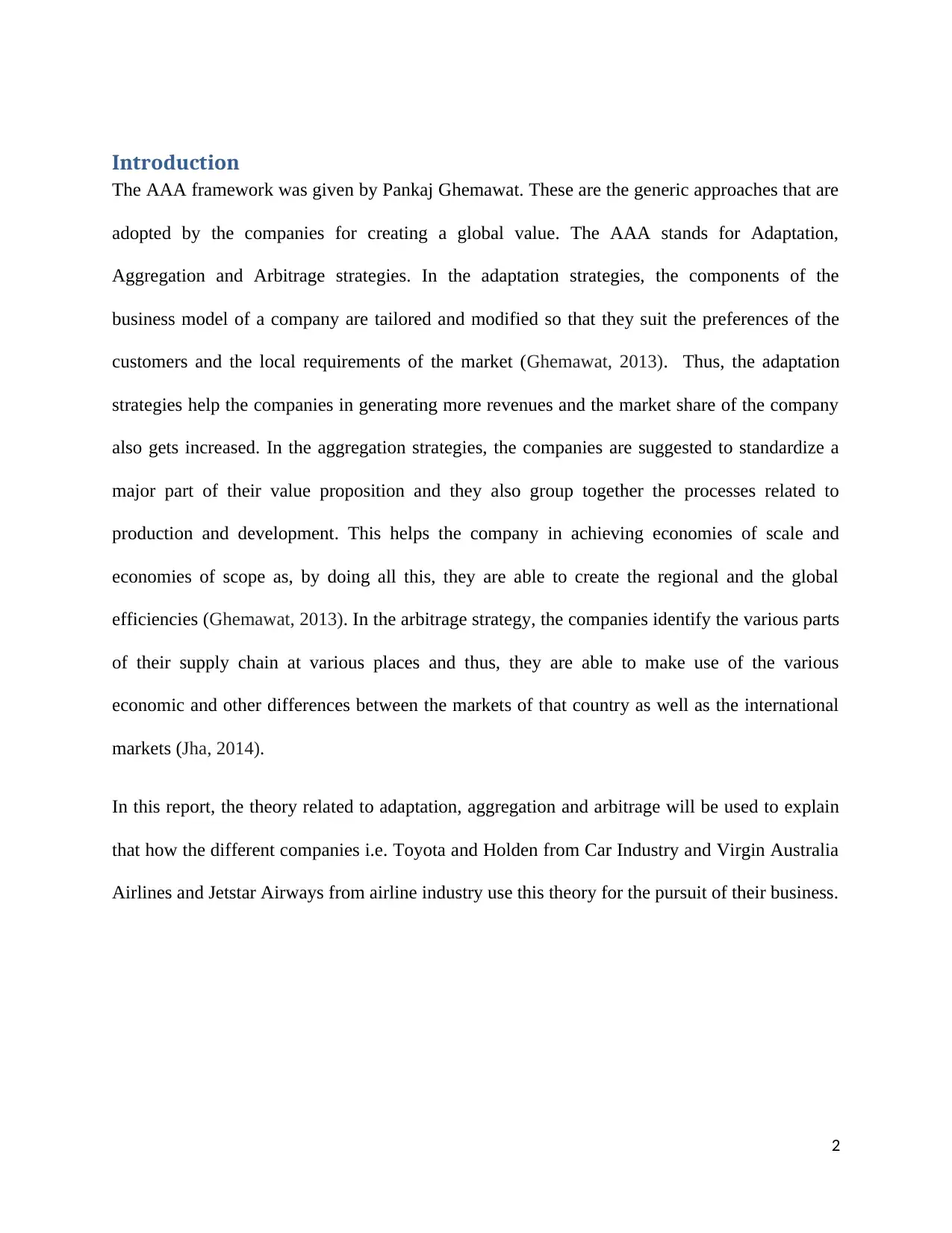
Introduction
The AAA framework was given by Pankaj Ghemawat. These are the generic approaches that are
adopted by the companies for creating a global value. The AAA stands for Adaptation,
Aggregation and Arbitrage strategies. In the adaptation strategies, the components of the
business model of a company are tailored and modified so that they suit the preferences of the
customers and the local requirements of the market (Ghemawat, 2013). Thus, the adaptation
strategies help the companies in generating more revenues and the market share of the company
also gets increased. In the aggregation strategies, the companies are suggested to standardize a
major part of their value proposition and they also group together the processes related to
production and development. This helps the company in achieving economies of scale and
economies of scope as, by doing all this, they are able to create the regional and the global
efficiencies (Ghemawat, 2013). In the arbitrage strategy, the companies identify the various parts
of their supply chain at various places and thus, they are able to make use of the various
economic and other differences between the markets of that country as well as the international
markets (Jha, 2014).
In this report, the theory related to adaptation, aggregation and arbitrage will be used to explain
that how the different companies i.e. Toyota and Holden from Car Industry and Virgin Australia
Airlines and Jetstar Airways from airline industry use this theory for the pursuit of their business.
2
The AAA framework was given by Pankaj Ghemawat. These are the generic approaches that are
adopted by the companies for creating a global value. The AAA stands for Adaptation,
Aggregation and Arbitrage strategies. In the adaptation strategies, the components of the
business model of a company are tailored and modified so that they suit the preferences of the
customers and the local requirements of the market (Ghemawat, 2013). Thus, the adaptation
strategies help the companies in generating more revenues and the market share of the company
also gets increased. In the aggregation strategies, the companies are suggested to standardize a
major part of their value proposition and they also group together the processes related to
production and development. This helps the company in achieving economies of scale and
economies of scope as, by doing all this, they are able to create the regional and the global
efficiencies (Ghemawat, 2013). In the arbitrage strategy, the companies identify the various parts
of their supply chain at various places and thus, they are able to make use of the various
economic and other differences between the markets of that country as well as the international
markets (Jha, 2014).
In this report, the theory related to adaptation, aggregation and arbitrage will be used to explain
that how the different companies i.e. Toyota and Holden from Car Industry and Virgin Australia
Airlines and Jetstar Airways from airline industry use this theory for the pursuit of their business.
2
⊘ This is a preview!⊘
Do you want full access?
Subscribe today to unlock all pages.

Trusted by 1+ million students worldwide
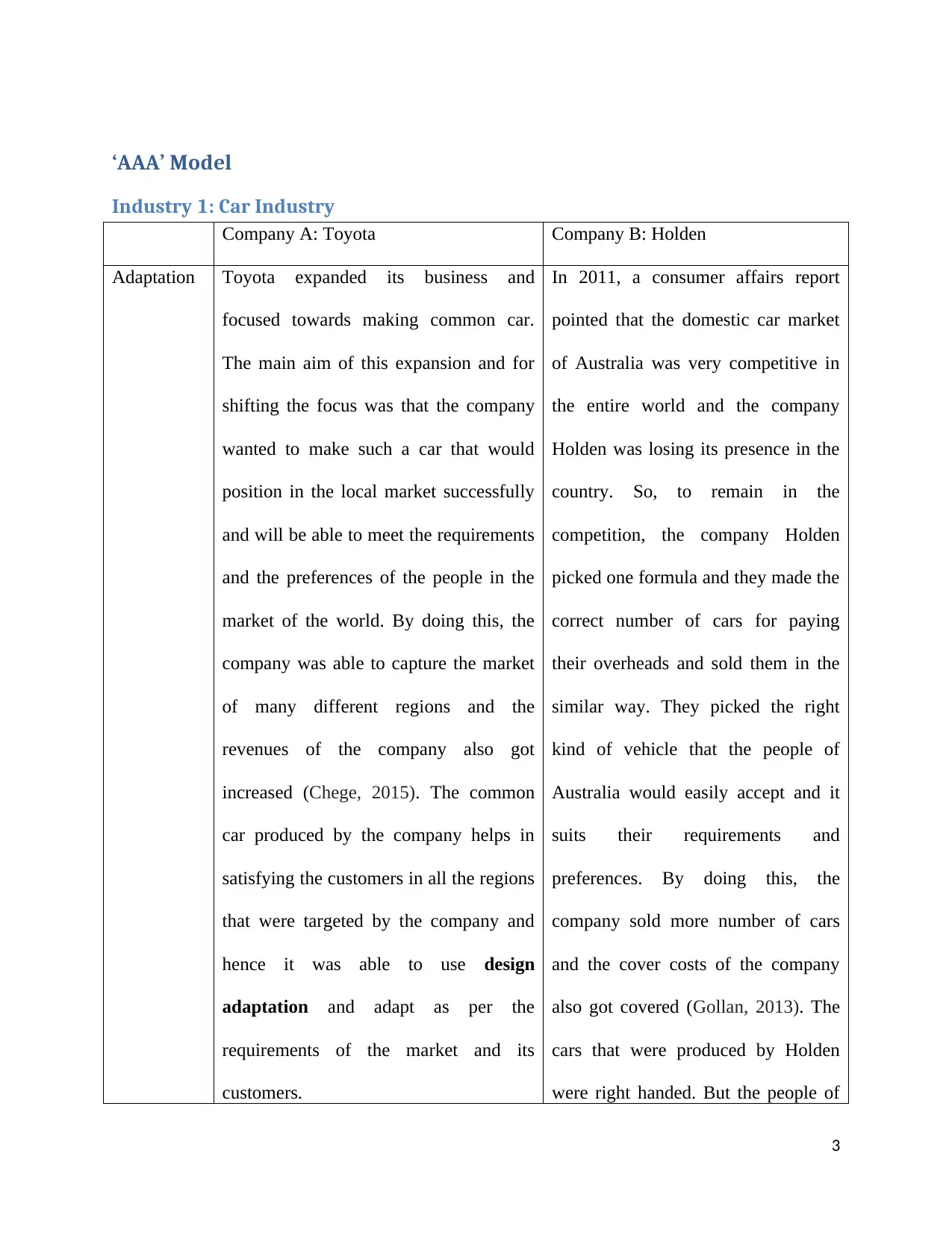
‘AAA’ Model
Industry 1: Car Industry
Company A: Toyota Company B: Holden
Adaptation Toyota expanded its business and
focused towards making common car.
The main aim of this expansion and for
shifting the focus was that the company
wanted to make such a car that would
position in the local market successfully
and will be able to meet the requirements
and the preferences of the people in the
market of the world. By doing this, the
company was able to capture the market
of many different regions and the
revenues of the company also got
increased (Chege, 2015). The common
car produced by the company helps in
satisfying the customers in all the regions
that were targeted by the company and
hence it was able to use design
adaptation and adapt as per the
requirements of the market and its
customers.
In 2011, a consumer affairs report
pointed that the domestic car market
of Australia was very competitive in
the entire world and the company
Holden was losing its presence in the
country. So, to remain in the
competition, the company Holden
picked one formula and they made the
correct number of cars for paying
their overheads and sold them in the
similar way. They picked the right
kind of vehicle that the people of
Australia would easily accept and it
suits their requirements and
preferences. By doing this, the
company sold more number of cars
and the cover costs of the company
also got covered (Gollan, 2013). The
cars that were produced by Holden
were right handed. But the people of
3
Industry 1: Car Industry
Company A: Toyota Company B: Holden
Adaptation Toyota expanded its business and
focused towards making common car.
The main aim of this expansion and for
shifting the focus was that the company
wanted to make such a car that would
position in the local market successfully
and will be able to meet the requirements
and the preferences of the people in the
market of the world. By doing this, the
company was able to capture the market
of many different regions and the
revenues of the company also got
increased (Chege, 2015). The common
car produced by the company helps in
satisfying the customers in all the regions
that were targeted by the company and
hence it was able to use design
adaptation and adapt as per the
requirements of the market and its
customers.
In 2011, a consumer affairs report
pointed that the domestic car market
of Australia was very competitive in
the entire world and the company
Holden was losing its presence in the
country. So, to remain in the
competition, the company Holden
picked one formula and they made the
correct number of cars for paying
their overheads and sold them in the
similar way. They picked the right
kind of vehicle that the people of
Australia would easily accept and it
suits their requirements and
preferences. By doing this, the
company sold more number of cars
and the cover costs of the company
also got covered (Gollan, 2013). The
cars that were produced by Holden
were right handed. But the people of
3
Paraphrase This Document
Need a fresh take? Get an instant paraphrase of this document with our AI Paraphraser
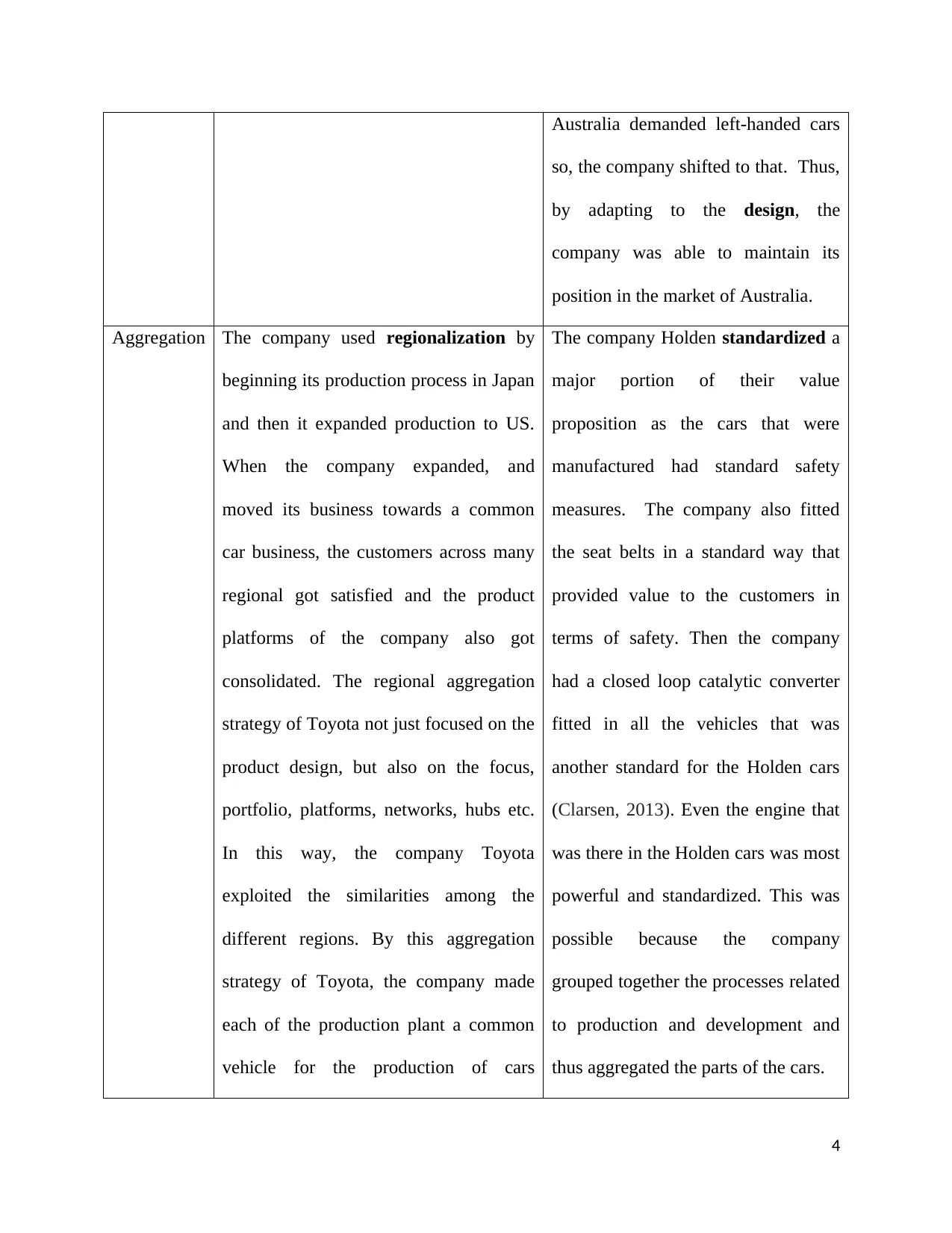
Australia demanded left-handed cars
so, the company shifted to that. Thus,
by adapting to the design, the
company was able to maintain its
position in the market of Australia.
Aggregation The company used regionalization by
beginning its production process in Japan
and then it expanded production to US.
When the company expanded, and
moved its business towards a common
car business, the customers across many
regional got satisfied and the product
platforms of the company also got
consolidated. The regional aggregation
strategy of Toyota not just focused on the
product design, but also on the focus,
portfolio, platforms, networks, hubs etc.
In this way, the company Toyota
exploited the similarities among the
different regions. By this aggregation
strategy of Toyota, the company made
each of the production plant a common
vehicle for the production of cars
The company Holden standardized a
major portion of their value
proposition as the cars that were
manufactured had standard safety
measures. The company also fitted
the seat belts in a standard way that
provided value to the customers in
terms of safety. Then the company
had a closed loop catalytic converter
fitted in all the vehicles that was
another standard for the Holden cars
(Clarsen, 2013). Even the engine that
was there in the Holden cars was most
powerful and standardized. This was
possible because the company
grouped together the processes related
to production and development and
thus aggregated the parts of the cars.
4
so, the company shifted to that. Thus,
by adapting to the design, the
company was able to maintain its
position in the market of Australia.
Aggregation The company used regionalization by
beginning its production process in Japan
and then it expanded production to US.
When the company expanded, and
moved its business towards a common
car business, the customers across many
regional got satisfied and the product
platforms of the company also got
consolidated. The regional aggregation
strategy of Toyota not just focused on the
product design, but also on the focus,
portfolio, platforms, networks, hubs etc.
In this way, the company Toyota
exploited the similarities among the
different regions. By this aggregation
strategy of Toyota, the company made
each of the production plant a common
vehicle for the production of cars
The company Holden standardized a
major portion of their value
proposition as the cars that were
manufactured had standard safety
measures. The company also fitted
the seat belts in a standard way that
provided value to the customers in
terms of safety. Then the company
had a closed loop catalytic converter
fitted in all the vehicles that was
another standard for the Holden cars
(Clarsen, 2013). Even the engine that
was there in the Holden cars was most
powerful and standardized. This was
possible because the company
grouped together the processes related
to production and development and
thus aggregated the parts of the cars.
4
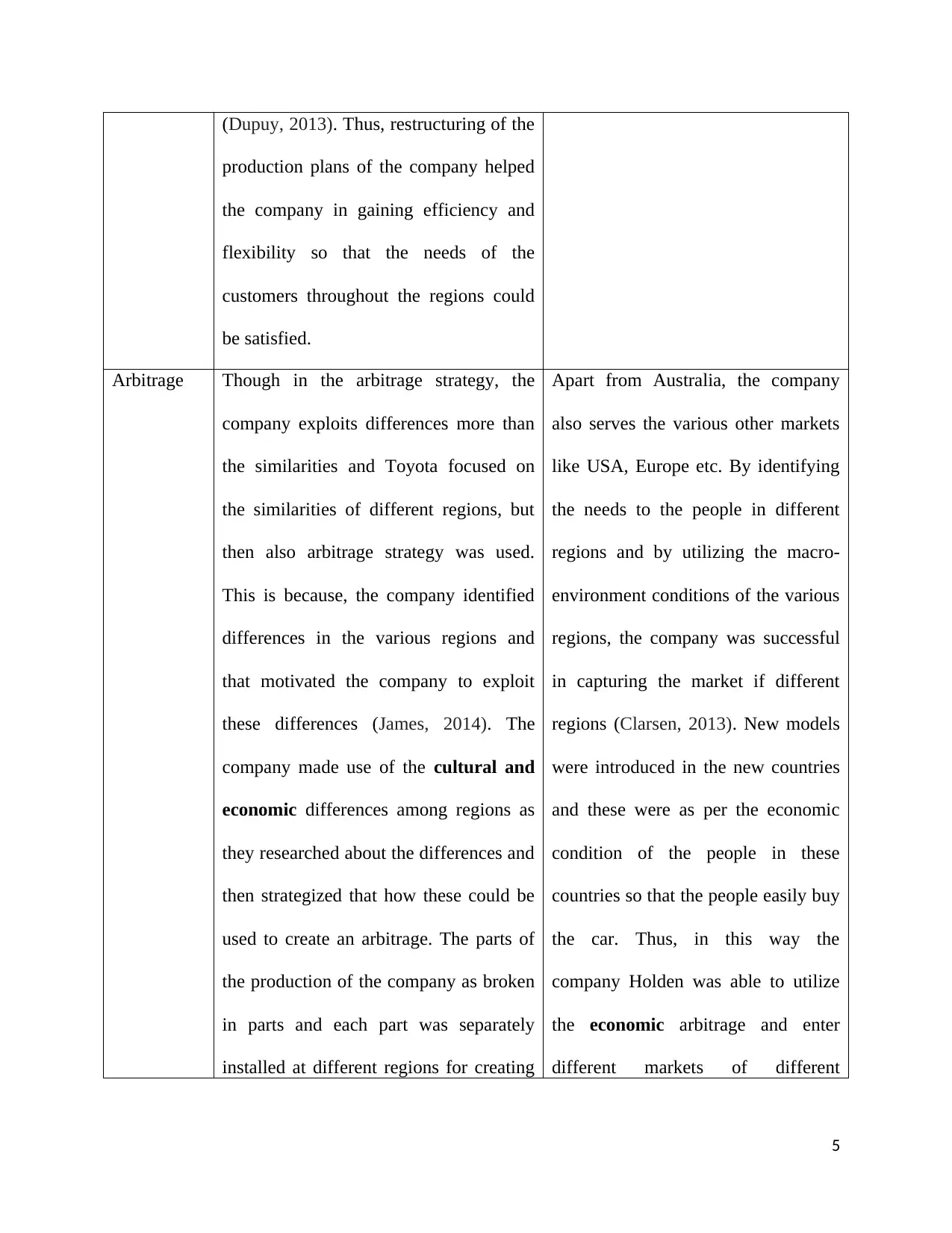
(Dupuy, 2013). Thus, restructuring of the
production plans of the company helped
the company in gaining efficiency and
flexibility so that the needs of the
customers throughout the regions could
be satisfied.
Arbitrage Though in the arbitrage strategy, the
company exploits differences more than
the similarities and Toyota focused on
the similarities of different regions, but
then also arbitrage strategy was used.
This is because, the company identified
differences in the various regions and
that motivated the company to exploit
these differences (James, 2014). The
company made use of the cultural and
economic differences among regions as
they researched about the differences and
then strategized that how these could be
used to create an arbitrage. The parts of
the production of the company as broken
in parts and each part was separately
installed at different regions for creating
Apart from Australia, the company
also serves the various other markets
like USA, Europe etc. By identifying
the needs to the people in different
regions and by utilizing the macro-
environment conditions of the various
regions, the company was successful
in capturing the market if different
regions (Clarsen, 2013). New models
were introduced in the new countries
and these were as per the economic
condition of the people in these
countries so that the people easily buy
the car. Thus, in this way the
company Holden was able to utilize
the economic arbitrage and enter
different markets of different
5
production plans of the company helped
the company in gaining efficiency and
flexibility so that the needs of the
customers throughout the regions could
be satisfied.
Arbitrage Though in the arbitrage strategy, the
company exploits differences more than
the similarities and Toyota focused on
the similarities of different regions, but
then also arbitrage strategy was used.
This is because, the company identified
differences in the various regions and
that motivated the company to exploit
these differences (James, 2014). The
company made use of the cultural and
economic differences among regions as
they researched about the differences and
then strategized that how these could be
used to create an arbitrage. The parts of
the production of the company as broken
in parts and each part was separately
installed at different regions for creating
Apart from Australia, the company
also serves the various other markets
like USA, Europe etc. By identifying
the needs to the people in different
regions and by utilizing the macro-
environment conditions of the various
regions, the company was successful
in capturing the market if different
regions (Clarsen, 2013). New models
were introduced in the new countries
and these were as per the economic
condition of the people in these
countries so that the people easily buy
the car. Thus, in this way the
company Holden was able to utilize
the economic arbitrage and enter
different markets of different
5
⊘ This is a preview!⊘
Do you want full access?
Subscribe today to unlock all pages.

Trusted by 1+ million students worldwide
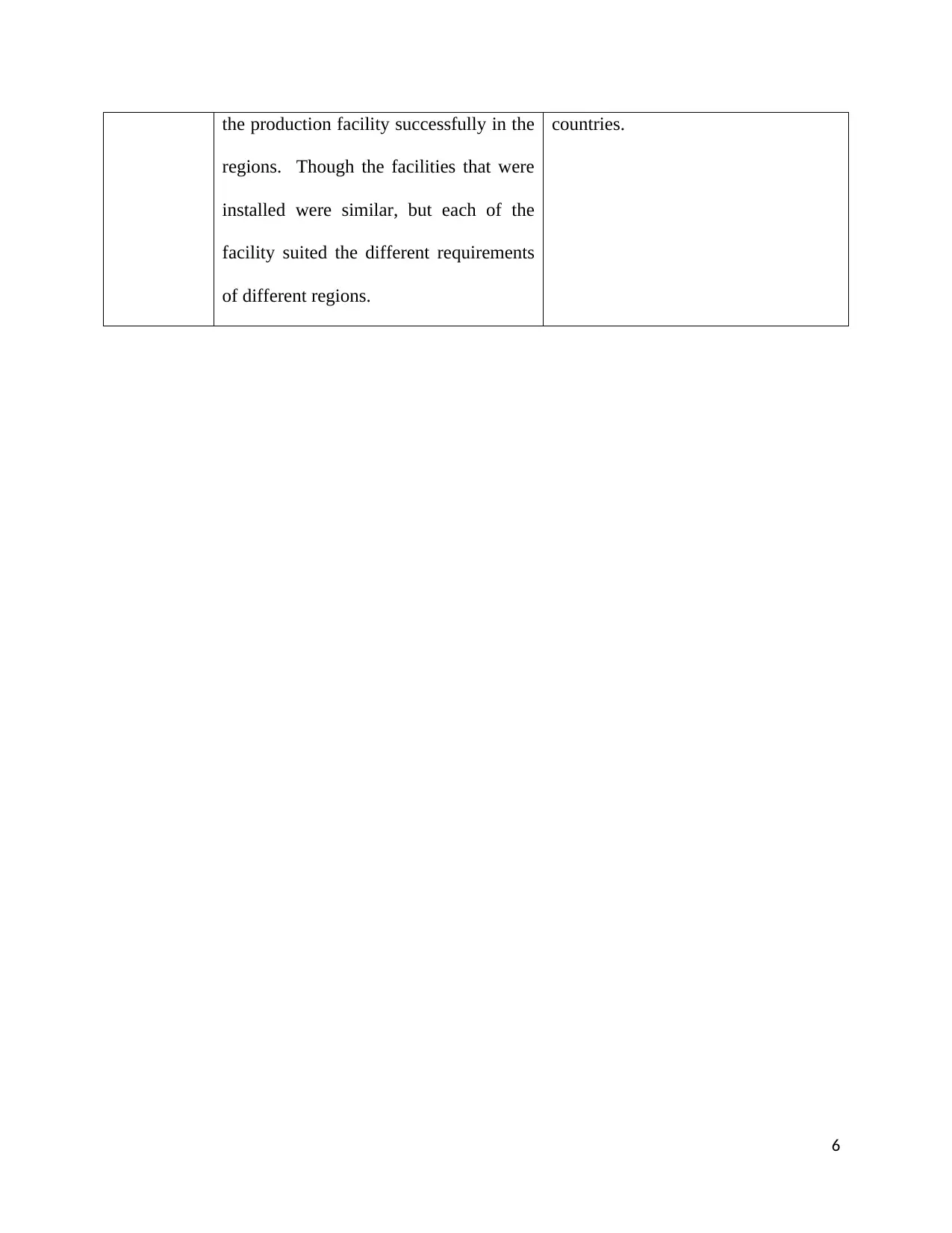
the production facility successfully in the
regions. Though the facilities that were
installed were similar, but each of the
facility suited the different requirements
of different regions.
countries.
6
regions. Though the facilities that were
installed were similar, but each of the
facility suited the different requirements
of different regions.
countries.
6
Paraphrase This Document
Need a fresh take? Get an instant paraphrase of this document with our AI Paraphraser
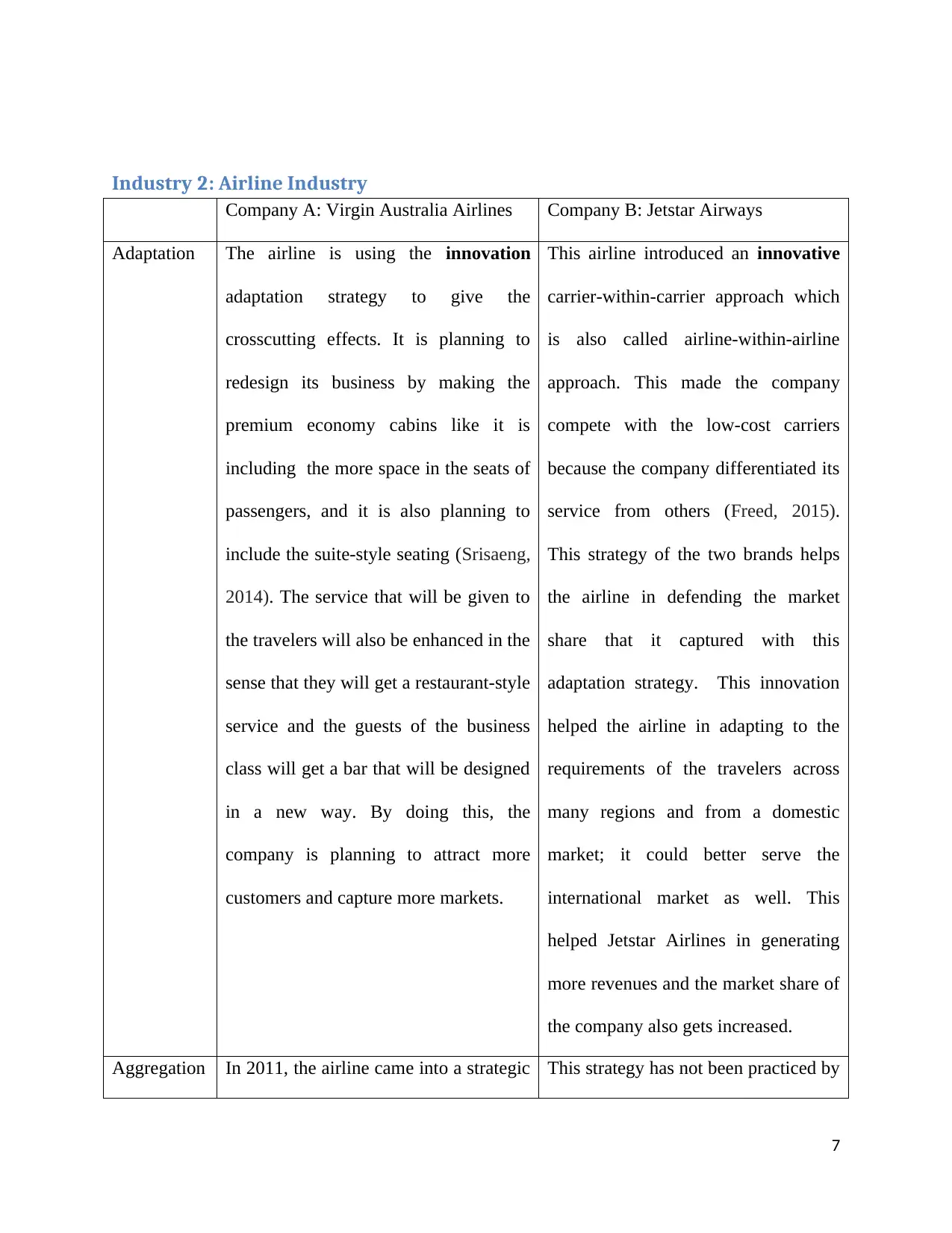
Industry 2: Airline Industry
Company A: Virgin Australia Airlines Company B: Jetstar Airways
Adaptation The airline is using the innovation
adaptation strategy to give the
crosscutting effects. It is planning to
redesign its business by making the
premium economy cabins like it is
including the more space in the seats of
passengers, and it is also planning to
include the suite-style seating (Srisaeng,
2014). The service that will be given to
the travelers will also be enhanced in the
sense that they will get a restaurant-style
service and the guests of the business
class will get a bar that will be designed
in a new way. By doing this, the
company is planning to attract more
customers and capture more markets.
This airline introduced an innovative
carrier-within-carrier approach which
is also called airline-within-airline
approach. This made the company
compete with the low-cost carriers
because the company differentiated its
service from others (Freed, 2015).
This strategy of the two brands helps
the airline in defending the market
share that it captured with this
adaptation strategy. This innovation
helped the airline in adapting to the
requirements of the travelers across
many regions and from a domestic
market; it could better serve the
international market as well. This
helped Jetstar Airlines in generating
more revenues and the market share of
the company also gets increased.
Aggregation In 2011, the airline came into a strategic This strategy has not been practiced by
7
Company A: Virgin Australia Airlines Company B: Jetstar Airways
Adaptation The airline is using the innovation
adaptation strategy to give the
crosscutting effects. It is planning to
redesign its business by making the
premium economy cabins like it is
including the more space in the seats of
passengers, and it is also planning to
include the suite-style seating (Srisaeng,
2014). The service that will be given to
the travelers will also be enhanced in the
sense that they will get a restaurant-style
service and the guests of the business
class will get a bar that will be designed
in a new way. By doing this, the
company is planning to attract more
customers and capture more markets.
This airline introduced an innovative
carrier-within-carrier approach which
is also called airline-within-airline
approach. This made the company
compete with the low-cost carriers
because the company differentiated its
service from others (Freed, 2015).
This strategy of the two brands helps
the airline in defending the market
share that it captured with this
adaptation strategy. This innovation
helped the airline in adapting to the
requirements of the travelers across
many regions and from a domestic
market; it could better serve the
international market as well. This
helped Jetstar Airlines in generating
more revenues and the market share of
the company also gets increased.
Aggregation In 2011, the airline came into a strategic This strategy has not been practiced by
7
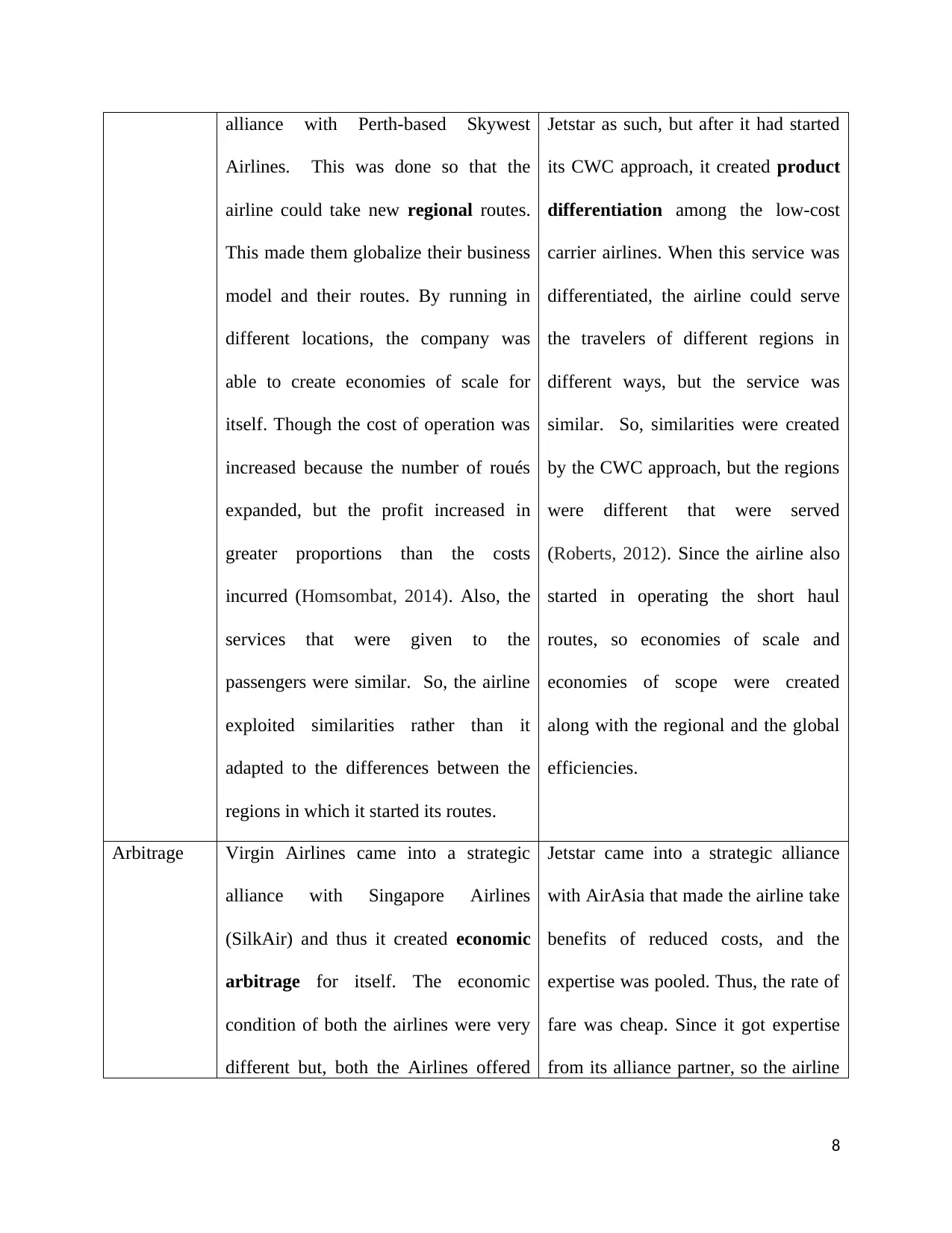
alliance with Perth-based Skywest
Airlines. This was done so that the
airline could take new regional routes.
This made them globalize their business
model and their routes. By running in
different locations, the company was
able to create economies of scale for
itself. Though the cost of operation was
increased because the number of roués
expanded, but the profit increased in
greater proportions than the costs
incurred (Homsombat, 2014). Also, the
services that were given to the
passengers were similar. So, the airline
exploited similarities rather than it
adapted to the differences between the
regions in which it started its routes.
Jetstar as such, but after it had started
its CWC approach, it created product
differentiation among the low-cost
carrier airlines. When this service was
differentiated, the airline could serve
the travelers of different regions in
different ways, but the service was
similar. So, similarities were created
by the CWC approach, but the regions
were different that were served
(Roberts, 2012). Since the airline also
started in operating the short haul
routes, so economies of scale and
economies of scope were created
along with the regional and the global
efficiencies.
Arbitrage Virgin Airlines came into a strategic
alliance with Singapore Airlines
(SilkAir) and thus it created economic
arbitrage for itself. The economic
condition of both the airlines were very
different but, both the Airlines offered
Jetstar came into a strategic alliance
with AirAsia that made the airline take
benefits of reduced costs, and the
expertise was pooled. Thus, the rate of
fare was cheap. Since it got expertise
from its alliance partner, so the airline
8
Airlines. This was done so that the
airline could take new regional routes.
This made them globalize their business
model and their routes. By running in
different locations, the company was
able to create economies of scale for
itself. Though the cost of operation was
increased because the number of roués
expanded, but the profit increased in
greater proportions than the costs
incurred (Homsombat, 2014). Also, the
services that were given to the
passengers were similar. So, the airline
exploited similarities rather than it
adapted to the differences between the
regions in which it started its routes.
Jetstar as such, but after it had started
its CWC approach, it created product
differentiation among the low-cost
carrier airlines. When this service was
differentiated, the airline could serve
the travelers of different regions in
different ways, but the service was
similar. So, similarities were created
by the CWC approach, but the regions
were different that were served
(Roberts, 2012). Since the airline also
started in operating the short haul
routes, so economies of scale and
economies of scope were created
along with the regional and the global
efficiencies.
Arbitrage Virgin Airlines came into a strategic
alliance with Singapore Airlines
(SilkAir) and thus it created economic
arbitrage for itself. The economic
condition of both the airlines were very
different but, both the Airlines offered
Jetstar came into a strategic alliance
with AirAsia that made the airline take
benefits of reduced costs, and the
expertise was pooled. Thus, the rate of
fare was cheap. Since it got expertise
from its alliance partner, so the airline
8
⊘ This is a preview!⊘
Do you want full access?
Subscribe today to unlock all pages.

Trusted by 1+ million students worldwide
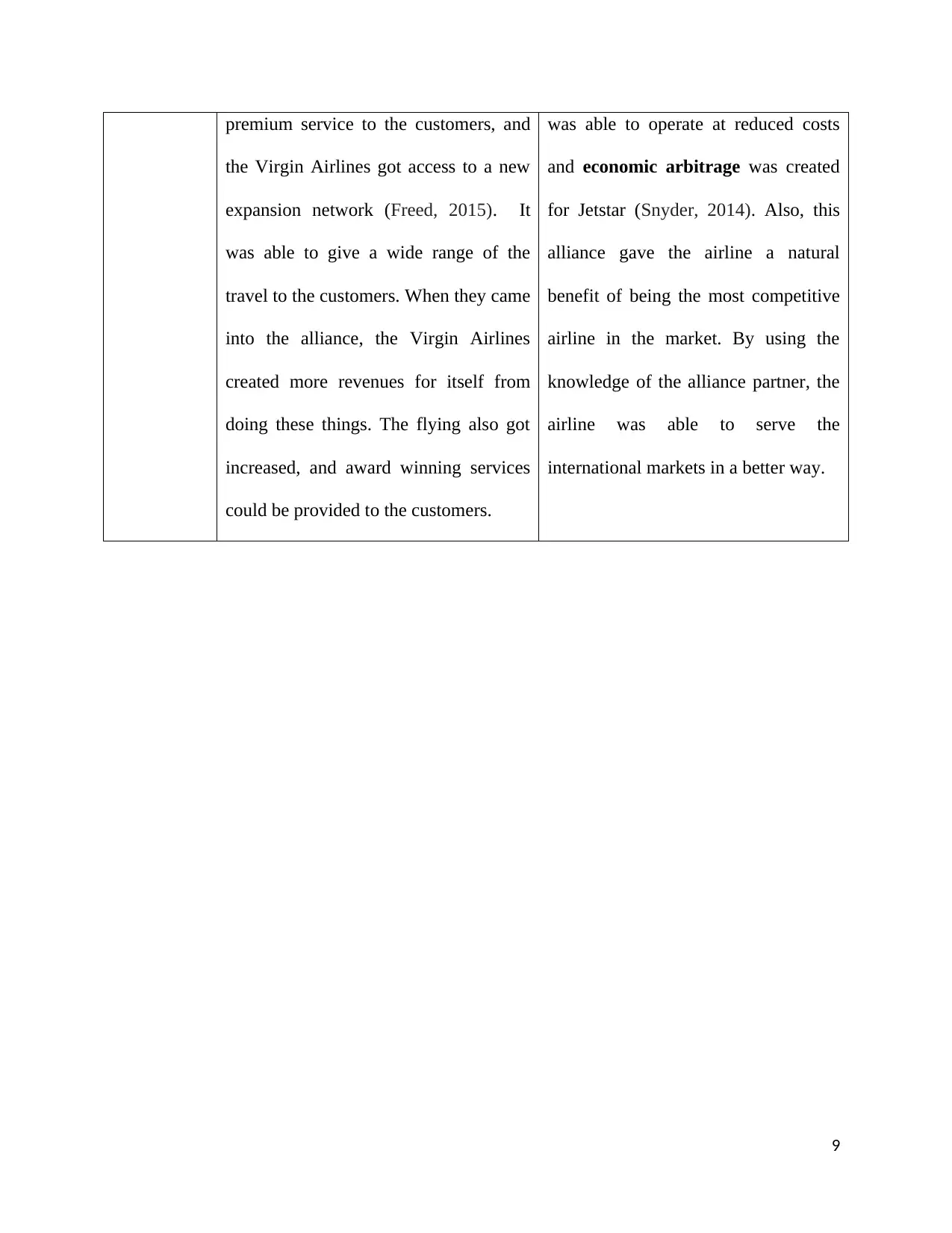
premium service to the customers, and
the Virgin Airlines got access to a new
expansion network (Freed, 2015). It
was able to give a wide range of the
travel to the customers. When they came
into the alliance, the Virgin Airlines
created more revenues for itself from
doing these things. The flying also got
increased, and award winning services
could be provided to the customers.
was able to operate at reduced costs
and economic arbitrage was created
for Jetstar (Snyder, 2014). Also, this
alliance gave the airline a natural
benefit of being the most competitive
airline in the market. By using the
knowledge of the alliance partner, the
airline was able to serve the
international markets in a better way.
9
the Virgin Airlines got access to a new
expansion network (Freed, 2015). It
was able to give a wide range of the
travel to the customers. When they came
into the alliance, the Virgin Airlines
created more revenues for itself from
doing these things. The flying also got
increased, and award winning services
could be provided to the customers.
was able to operate at reduced costs
and economic arbitrage was created
for Jetstar (Snyder, 2014). Also, this
alliance gave the airline a natural
benefit of being the most competitive
airline in the market. By using the
knowledge of the alliance partner, the
airline was able to serve the
international markets in a better way.
9
Paraphrase This Document
Need a fresh take? Get an instant paraphrase of this document with our AI Paraphraser
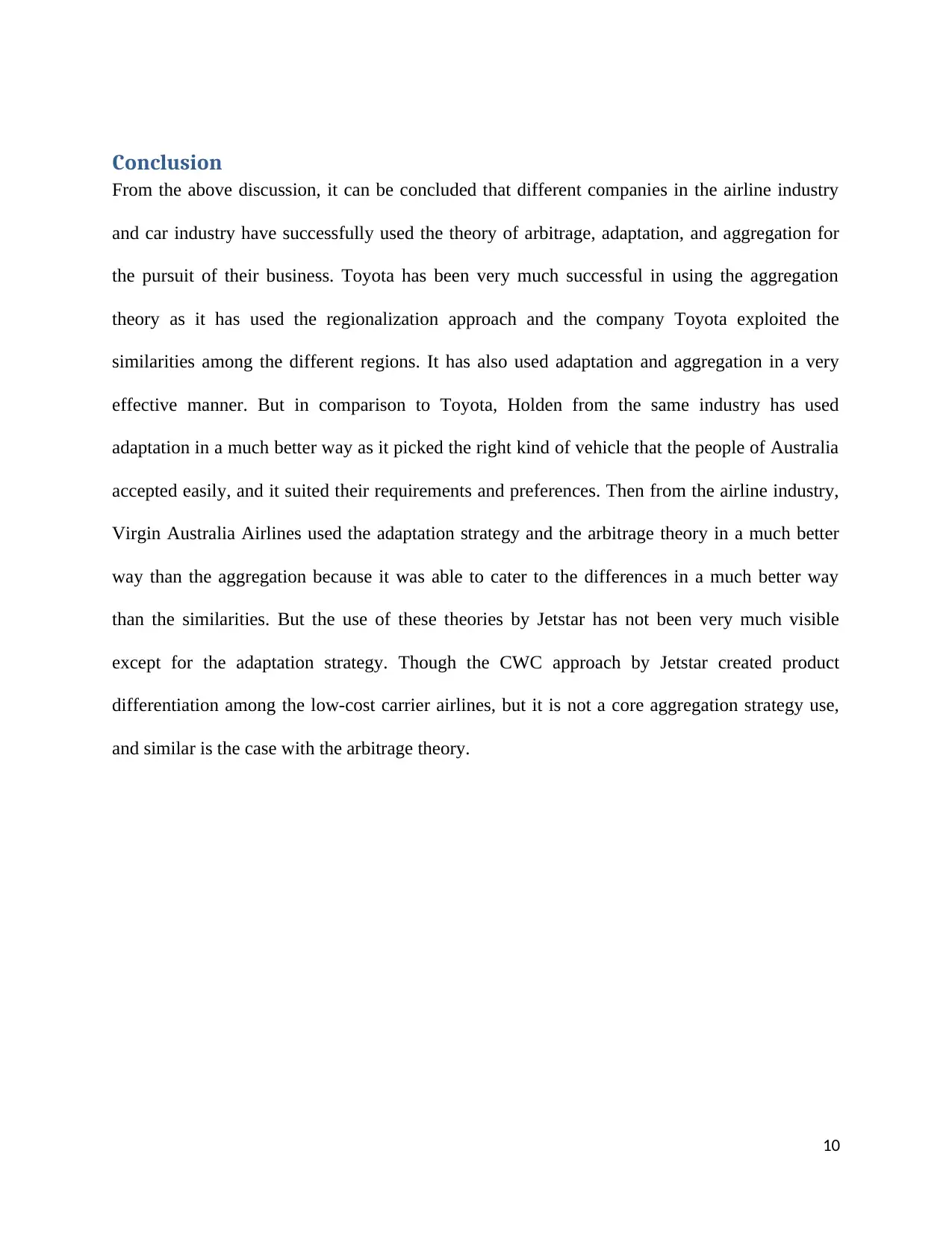
Conclusion
From the above discussion, it can be concluded that different companies in the airline industry
and car industry have successfully used the theory of arbitrage, adaptation, and aggregation for
the pursuit of their business. Toyota has been very much successful in using the aggregation
theory as it has used the regionalization approach and the company Toyota exploited the
similarities among the different regions. It has also used adaptation and aggregation in a very
effective manner. But in comparison to Toyota, Holden from the same industry has used
adaptation in a much better way as it picked the right kind of vehicle that the people of Australia
accepted easily, and it suited their requirements and preferences. Then from the airline industry,
Virgin Australia Airlines used the adaptation strategy and the arbitrage theory in a much better
way than the aggregation because it was able to cater to the differences in a much better way
than the similarities. But the use of these theories by Jetstar has not been very much visible
except for the adaptation strategy. Though the CWC approach by Jetstar created product
differentiation among the low-cost carrier airlines, but it is not a core aggregation strategy use,
and similar is the case with the arbitrage theory.
10
From the above discussion, it can be concluded that different companies in the airline industry
and car industry have successfully used the theory of arbitrage, adaptation, and aggregation for
the pursuit of their business. Toyota has been very much successful in using the aggregation
theory as it has used the regionalization approach and the company Toyota exploited the
similarities among the different regions. It has also used adaptation and aggregation in a very
effective manner. But in comparison to Toyota, Holden from the same industry has used
adaptation in a much better way as it picked the right kind of vehicle that the people of Australia
accepted easily, and it suited their requirements and preferences. Then from the airline industry,
Virgin Australia Airlines used the adaptation strategy and the arbitrage theory in a much better
way than the aggregation because it was able to cater to the differences in a much better way
than the similarities. But the use of these theories by Jetstar has not been very much visible
except for the adaptation strategy. Though the CWC approach by Jetstar created product
differentiation among the low-cost carrier airlines, but it is not a core aggregation strategy use,
and similar is the case with the arbitrage theory.
10
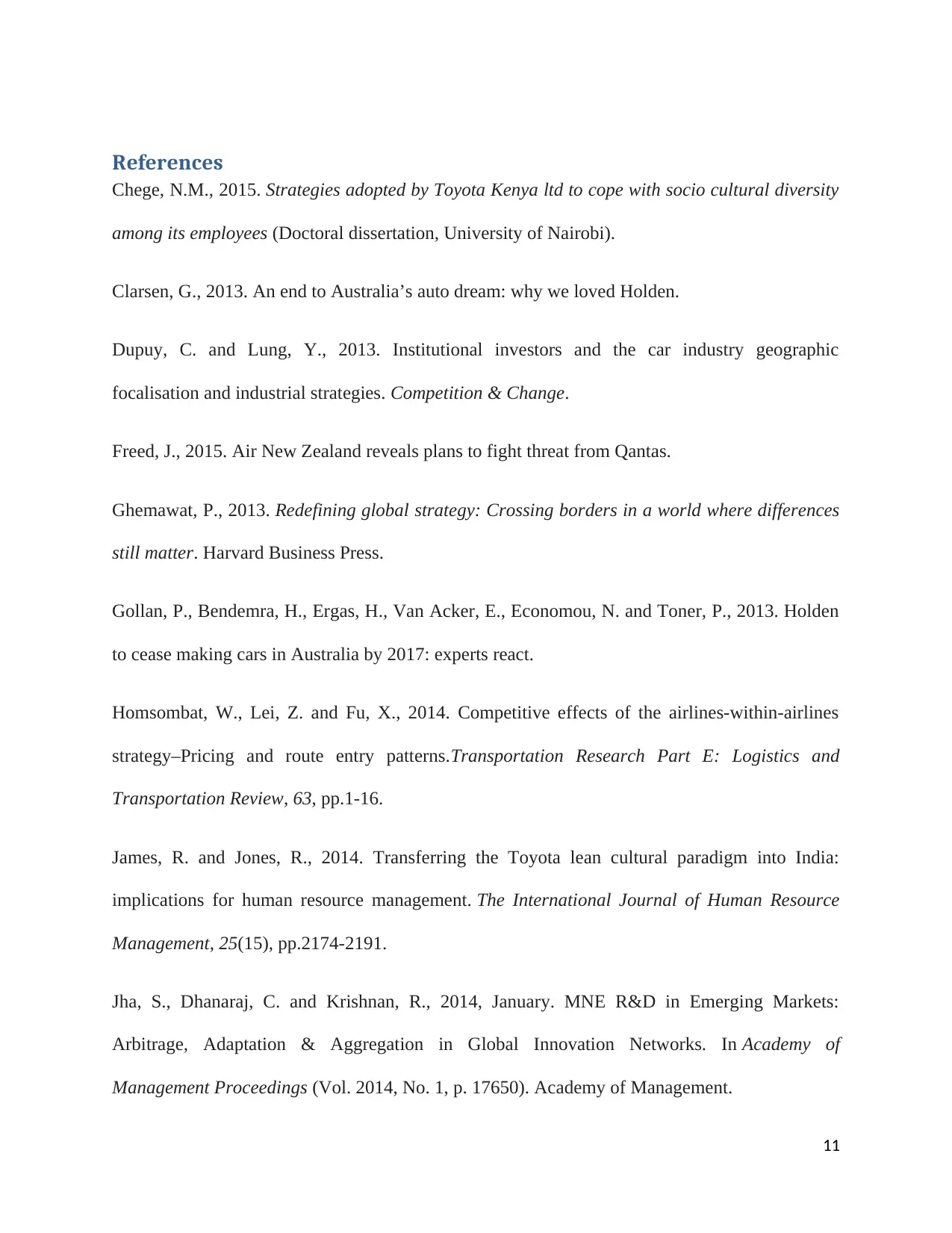
References
Chege, N.M., 2015. Strategies adopted by Toyota Kenya ltd to cope with socio cultural diversity
among its employees (Doctoral dissertation, University of Nairobi).
Clarsen, G., 2013. An end to Australia’s auto dream: why we loved Holden.
Dupuy, C. and Lung, Y., 2013. Institutional investors and the car industry geographic
focalisation and industrial strategies. Competition & Change.
Freed, J., 2015. Air New Zealand reveals plans to fight threat from Qantas.
Ghemawat, P., 2013. Redefining global strategy: Crossing borders in a world where differences
still matter. Harvard Business Press.
Gollan, P., Bendemra, H., Ergas, H., Van Acker, E., Economou, N. and Toner, P., 2013. Holden
to cease making cars in Australia by 2017: experts react.
Homsombat, W., Lei, Z. and Fu, X., 2014. Competitive effects of the airlines-within-airlines
strategy–Pricing and route entry patterns.Transportation Research Part E: Logistics and
Transportation Review, 63, pp.1-16.
James, R. and Jones, R., 2014. Transferring the Toyota lean cultural paradigm into India:
implications for human resource management. The International Journal of Human Resource
Management, 25(15), pp.2174-2191.
Jha, S., Dhanaraj, C. and Krishnan, R., 2014, January. MNE R&D in Emerging Markets:
Arbitrage, Adaptation & Aggregation in Global Innovation Networks. In Academy of
Management Proceedings (Vol. 2014, No. 1, p. 17650). Academy of Management.
11
Chege, N.M., 2015. Strategies adopted by Toyota Kenya ltd to cope with socio cultural diversity
among its employees (Doctoral dissertation, University of Nairobi).
Clarsen, G., 2013. An end to Australia’s auto dream: why we loved Holden.
Dupuy, C. and Lung, Y., 2013. Institutional investors and the car industry geographic
focalisation and industrial strategies. Competition & Change.
Freed, J., 2015. Air New Zealand reveals plans to fight threat from Qantas.
Ghemawat, P., 2013. Redefining global strategy: Crossing borders in a world where differences
still matter. Harvard Business Press.
Gollan, P., Bendemra, H., Ergas, H., Van Acker, E., Economou, N. and Toner, P., 2013. Holden
to cease making cars in Australia by 2017: experts react.
Homsombat, W., Lei, Z. and Fu, X., 2014. Competitive effects of the airlines-within-airlines
strategy–Pricing and route entry patterns.Transportation Research Part E: Logistics and
Transportation Review, 63, pp.1-16.
James, R. and Jones, R., 2014. Transferring the Toyota lean cultural paradigm into India:
implications for human resource management. The International Journal of Human Resource
Management, 25(15), pp.2174-2191.
Jha, S., Dhanaraj, C. and Krishnan, R., 2014, January. MNE R&D in Emerging Markets:
Arbitrage, Adaptation & Aggregation in Global Innovation Networks. In Academy of
Management Proceedings (Vol. 2014, No. 1, p. 17650). Academy of Management.
11
⊘ This is a preview!⊘
Do you want full access?
Subscribe today to unlock all pages.

Trusted by 1+ million students worldwide
1 out of 13
Related Documents
Your All-in-One AI-Powered Toolkit for Academic Success.
+13062052269
info@desklib.com
Available 24*7 on WhatsApp / Email
![[object Object]](/_next/static/media/star-bottom.7253800d.svg)
Unlock your academic potential
Copyright © 2020–2025 A2Z Services. All Rights Reserved. Developed and managed by ZUCOL.





